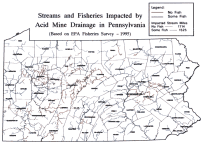During 200 years of coal mining, Pennsylvania produced more than 25
percent of the nation's total coal output and presently ranks fourth
in the nation in annual coal production by state. Coalfields are included
within, or extend into, the four major river basins in Pennsylvania--the
Ohio, Susquehanna, Potomac, and Delaware River Basins. Bituminous coal
deposits underlie western and north-central Pennsylvania, and anthracite
deposits underlie east-central and northeastern Pennsylvania (figure
1). Pennsylvania's bituminous coal is used primarily for electric-power
generation; anthracite coal is used for electric-power generation and
home heating.

Figure 1.--Bituminous
and anthracite coal fields in Pennsylvania
Drainage from thousands of abandoned coal mines has contaminated more
than 3,000 miles of streams and associated ground waters in Pennsylvania
and is the most extensive water-pollution problem affecting the four
major river basins in Pennsylvania. Because coal-mine drainage can contain
toxic concentrations of acidity, metals, and sediment, many of the mining
impacted streams contain "no fish"
(figure 2). Consequently, Pennsylvania loses approximately $67 million
annually that could be generated if sport fishing were restored in the
affected streams. The estimated cost for restoring the damaged watersheds
is $5 billion to $15 billion.

Figure 2.--Streams and
fisheries impacted by coal-mine drainage in Pennsylvania (From U.S.
Environmental Protection Agency)
About half of the coal-mine discharges in Pennsylvania are acidic,
with pH <5 (figure 3a;
figure 3b). Generally, limestone or other calcareous strata that
could neutralize acid are lacking or deficient at sites that produce
acidic mine drainage (AMD). Although abandoned underground mines produce
most of the AMD, some recently mined and reclaimed surface mines have
produced AMD and have degraded local groundwater and surface-water resources.
Acidic water produced at active mines must be neutralized to achieve
pH 6-9 before discharge from a mine site to a stream is permitted.
Return
to AMD Stakeholders' page
